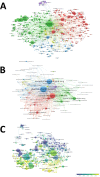From disease management to prevention, hip prosthesis joint infections in the past 20 years: a global research trends and top 10 cited articles analysis
- PMID: 39845026
- PMCID: PMC11752910
- DOI: 10.3389/fsurg.2024.1448049
From disease management to prevention, hip prosthesis joint infections in the past 20 years: a global research trends and top 10 cited articles analysis
Abstract
Background: There are few literatures comprehensively analyzed the global research in hip prosthesis joint infections (HPJI). We aim to clarify the global research trends and analysis the top 10 cited articles in the HPJI field.
Methods: We identified the core collection of articles/reviews in the HPJI field from 2001 to 2021 through the Web of Science Core Collection (WOSCC). VOSviewer and online bibliometric tool were used to conduct the visualized and knowledge maps. Annual trends of publications, research hotspots and the top 10 cited articles were analyzed.
Results: A total of 5,477 publications were finally included. Generally, an increasing trend was observed in the number of publications from 2001 to 2021. The authors, journals and institutions with largest number of publications all belong to the USA. Co-occurrence analysis of keywords showed that surgical techniques, risk factors, revision surgery strategy, epidemiology, diagnoses and prevention were the 6 major research directions. Total hip arthroplasty, replacement, outcomes, risk factors and diagnosis were the keywords that occurred most frequently. The top 10 cited articles were all published in Journal Citation Reports (JCR) Q1 journals, providing valuable reference value from the perspectives of clinical guidelines, perioperative management, causes and diagnostic methods of infection, epidemiological investigation, risk factors and prognostic analysis.
Conclusions: The number of publications in HPJI field had been on the rise over the past 20 years, from disease management to prevention. An intensive reading of the top 10 cited articles is beneficial to understand the focus of HPJI research comprehensively.
Keywords: bibliometric analysis; highly cited articles background; hip; prosthesis joint infections; research trends.
© 2025 Li, Qi, Chen and Zeng.
Conflict of interest statement
The authors declare that the research was conducted in the absence of any commercial or financial relationships that could be construed as a potential conflict of interest.
Figures







Similar articles
-
The top 100 most cited articles on intramedullary nail fixation from 2018-2022: a bibliometric and visualized analysis.Eur Rev Med Pharmacol Sci. 2024 Mar;28(5):1662-1679. doi: 10.26355/eurrev_202403_35582. Eur Rev Med Pharmacol Sci. 2024. PMID: 38497851 Review.
-
Research Progress and Hot Topics in Telerehabilitation for Hip or Knee Arthroplasty.Orthop Surg. 2025 Mar;17(3):677-693. doi: 10.1111/os.14347. Epub 2025 Jan 5. Orthop Surg. 2025. PMID: 39757734 Free PMC article. Review.
-
Global research trends of antibiotic-loaded bone cement: A bibliometric and visualized study.Heliyon. 2024 Aug 22;10(17):e36720. doi: 10.1016/j.heliyon.2024.e36720. eCollection 2024 Sep 15. Heliyon. 2024. PMID: 39263064 Free PMC article.
-
The top 100 highly cited articles on anterior cruciate ligament from 2000 to 2019: A bibliometric and visualized analysis.Orthop Traumatol Surg Res. 2021 Dec;107(8):102988. doi: 10.1016/j.otsr.2021.102988. Epub 2021 Jun 17. Orthop Traumatol Surg Res. 2021. PMID: 34146752
-
The Top-Cited Original Articles on the Role of Microglia in Neurodegenerative Diseases: A Bibliometric and Visualized Study.Front Aging Neurosci. 2022 Apr 5;14:869964. doi: 10.3389/fnagi.2022.869964. eCollection 2022. Front Aging Neurosci. 2022. PMID: 35478696 Free PMC article.
References
-
- Wu VJ, Iloanya MC, Sanchez FL, Billings CR, O'Brien MJ, Savoie FR, et al. Is patient-reported penicillin allergy independently associated with increased risk of prosthetic joint infection after total joint arthroplasty of the hip, knee, and shoulder? Clin Orthop Relat Res. (2020) 478(12):2699–709. 10.1097/CORR.0000000000001497 - DOI - PMC - PubMed
LinkOut - more resources
Full Text Sources
Miscellaneous

